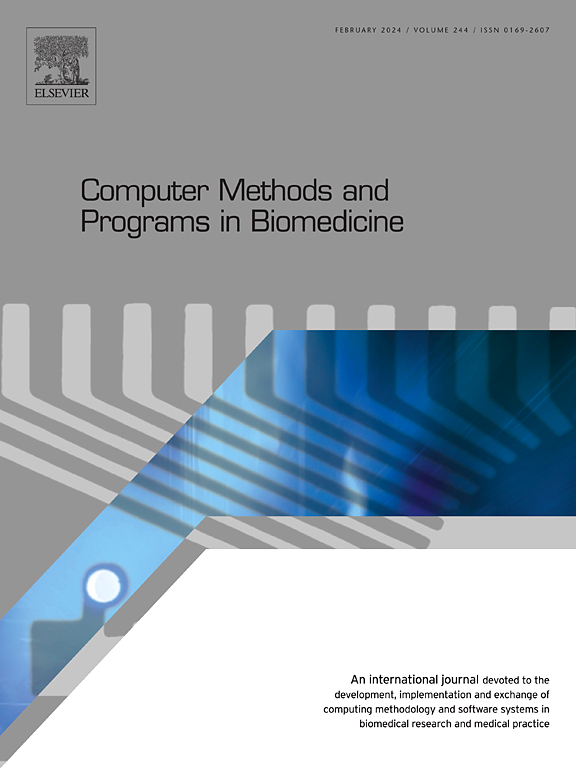Weakly-supervised segmentation using sparse single point annotations for lumen and wall of carotid arteries in 3D MRI
IF 4.9
2区 医学
Q1 COMPUTER SCIENCE, INTERDISCIPLINARY APPLICATIONS
引用次数: 0
Abstract
Background and objective:
Segmentation of the carotid artery is a crucial step in planning therapy for atherosclerosis. Manual annotation is a time-consuming and labor-intensive process, and there is a need to reduce this effort.
Methods:
We propose a weakly supervised segmentation method using only a few annotated axial slices, each with a single-point annotation from 3D magnetic resonance imaging for the lumen and wall of the carotid artery. The proposed method contains three loss functions designed to (1) locate the center point of the vessel, (2) constrain the range of the vessel radius using prior information implemented with spatial maps, and (3) encourage similar segmentation results in adjacent slices. Both the lumen (inner structure) and wall (outer structure) can be segmented by adjusting the range of plausible radii.
Results:
Experimental evaluations on the COSMOS2022 dataset show that our method achieved similar performance results ( 0.821 lumen, 0.841 wall) to those of fully supervised methods with dense annotations ( 0.814-0.857, 0.832-0.875). Similar trends were observed on an independent Harvard dataset.
Conclusion:
Our proposed method demonstrated effective segmentation of crucial arteries, internal carotid artery, external carotid artery, and common carotid artery in atherosclerosis. We anticipate that this efficient approach utilizing single-point annotation will contribute to the effective management of carotid atherosclerosis. Our code is available at https://github.com/jongdory/CASCA.
基于稀疏单点注释的三维MRI颈动脉腔和管壁弱监督分割
背景与目的:颈动脉分割是动脉粥样硬化治疗计划的关键步骤。手动注释是一个耗时且费力的过程,需要减少这种工作量。方法:我们提出了一种弱监督分割方法,仅使用少量注释轴向切片,每个切片都有一个单点注释,这些注释来自颈动脉管腔和壁的3D磁共振成像。该方法包含三个损失函数,分别用于(1)定位血管中心点,(2)使用空间地图实现的先验信息约束血管半径范围,以及(3)鼓励相邻切片中相似的分割结果。管腔(内部结构)和壁(外部结构)都可以通过调整似是而非的半径范围来分割。结果:在COSMOS2022数据集上的实验评估表明,我们的方法与具有密集注释的完全监督方法(DSClu 0.814-0.857, DSCwa 0.832-0.875)取得了相似的性能结果(DSClu 0.821 lumen, DSCwa 0.841 wall)。哈佛大学的一个独立数据集也观察到了类似的趋势。结论:该方法对动脉粥样硬化的关键动脉、颈内动脉、颈外动脉和颈总动脉进行了有效的分割。我们预计这种利用单点注释的有效方法将有助于有效地管理颈动脉粥样硬化。我们的代码可在https://github.com/jongdory/CASCA上获得。
本文章由计算机程序翻译,如有差异,请以英文原文为准。
求助全文
约1分钟内获得全文
求助全文
来源期刊

Computer methods and programs in biomedicine
工程技术-工程:生物医学
CiteScore
12.30
自引率
6.60%
发文量
601
审稿时长
135 days
期刊介绍:
To encourage the development of formal computing methods, and their application in biomedical research and medical practice, by illustration of fundamental principles in biomedical informatics research; to stimulate basic research into application software design; to report the state of research of biomedical information processing projects; to report new computer methodologies applied in biomedical areas; the eventual distribution of demonstrable software to avoid duplication of effort; to provide a forum for discussion and improvement of existing software; to optimize contact between national organizations and regional user groups by promoting an international exchange of information on formal methods, standards and software in biomedicine.
Computer Methods and Programs in Biomedicine covers computing methodology and software systems derived from computing science for implementation in all aspects of biomedical research and medical practice. It is designed to serve: biochemists; biologists; geneticists; immunologists; neuroscientists; pharmacologists; toxicologists; clinicians; epidemiologists; psychiatrists; psychologists; cardiologists; chemists; (radio)physicists; computer scientists; programmers and systems analysts; biomedical, clinical, electrical and other engineers; teachers of medical informatics and users of educational software.
 求助内容:
求助内容: 应助结果提醒方式:
应助结果提醒方式:


